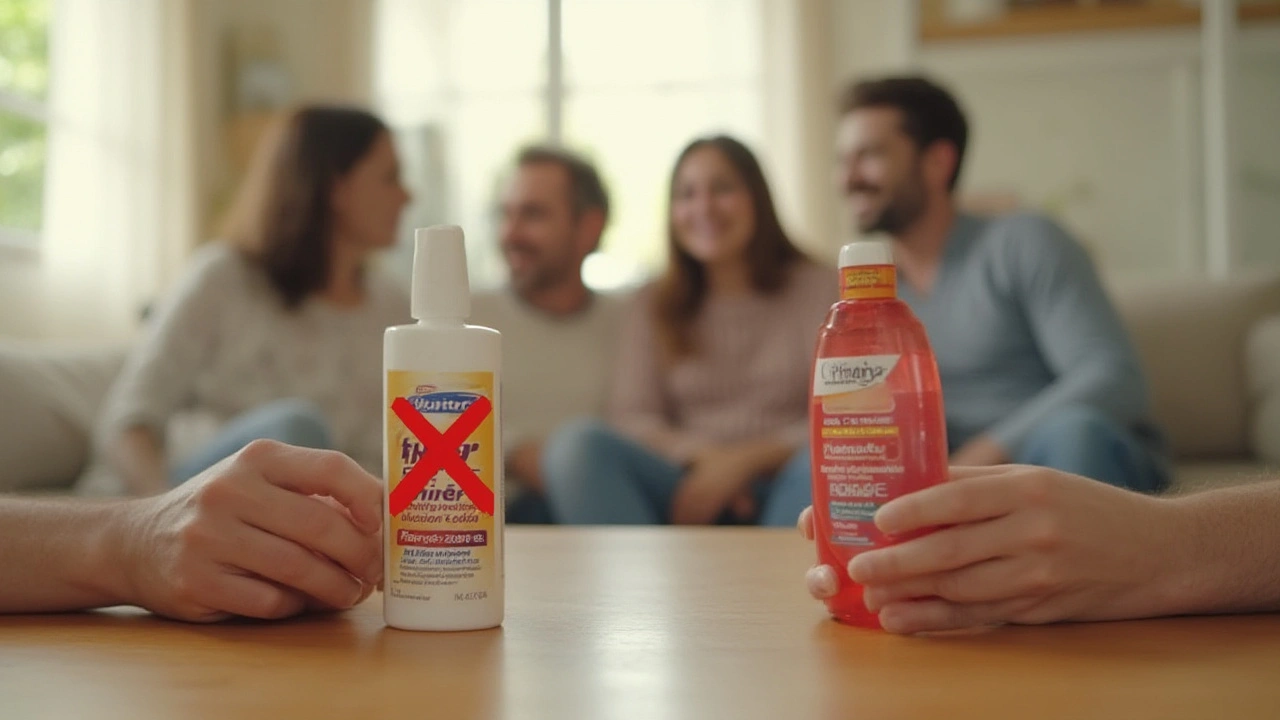Every spring, my house looks like a tissue blizzard blew through. If you’ve battled allergic rhinitis, you know what I mean—itchy eyes, stuffy nose, and sneezing fits that don't quit. For years, Flonase was my go-to until I started worrying about side effects from long-term steroid use. I’m not alone. There’s actually growing interest in non-steroid options, especially among people who hate being on steroids year-round. But where do you start? The market is flooded with nose sprays, and not all are created equal. Today, I’m laying out what science says, and what actually works, when it comes to fighting allergies without steroids.
Why Seek Non-Steroid Alternatives for Allergic Rhinitis?
Most folks grab a steroid spray, like Flonase, without much thought. Flonase (fluticasone propionate) can work wonders—it calms inflammation and controls the runny festivities in your nose. But even though steroids in nasal form are less risky than pills, side effects aren’t just hype. Steroid nasal sprays can lead to nosebleeds, headaches, dryness, and, on rare occasions, stunted growth in kids or thinning of the nose lining. When you use them for months on end, some people develop rebound symptoms when stopping, making it tough to wean off.
It’s not paranoia if you want to avoid steroids, especially if you only have mild symptoms, are pregnant, or have other risk factors. Some allergy folks can’t use them at all for medical reasons—think glaucoma, recent nasal surgery, or certain infections. That’s where non-steroid alternatives jump in. The biggest benefit? Less worry about systemic side effects and safer options for year-round use. And if you’re anything like me and hate relying on one med forever, it just makes sense to know your options. In fact, a 2023 review found over 30% of patients with allergic rhinitis would prefer starting with non-steroid treatments, especially if they have mild symptoms or want to avoid medication dependence.
There are also lifestyle benefits. A non-steroid nose spray won’t leave you second-guessing every dry patch in your nose. You don’t have to stress about long-term risks that lurk in the background, especially if you’re young and otherwise healthy. And, let’s face it, nobody likes reading side effect lists that sound like a horror movie script. This is why the search for a non steroid alternative to Flonase is getting more popular, according to allergy forums and new research trends alike.
Antihistamine Nasal Sprays: The Science and the Experience
You've probably tried oral antihistamines for allergies before. But antihistamine nose sprays work directly where the action is, blocking histamine—the culprit behind sneezing, itching, and runny noses—right at the tissue. Azelastine and olopatadine are two top choices here, both FDA-approved for allergic rhinitis. Here’s where it gets interesting: nasal antihistamines actually kick in faster than steroid sprays. We're talking relief in 15-30 minutes. A 2022 study compared azelastine with fluticasone—azalestine had similar effectiveness for mild symptoms, and people reported fewer issues like nose dryness or nosebleeds. The main annoyance? Some say it tastes weird if it drips down your throat. But if you angle your head right, you dodge most of the bad aftertaste.
These sprays are a solid fit if your main issues are sneezing and a runny nose (as opposed to super-blocked-up congestion). Doctors often suggest trying antihistamine sprays first for mild-to-moderate symptoms, or using them while you’re giving your sinuses a break from steroids. Bonus: they’re considered safe for long-term use, with way fewer worries about systemic side effects. For real-world tips, don’t spray too hard—just a quick, gentle squeeze is enough. Shake the bottle well before each use, and keep your head tilted slightly forward. Whether you’re allergic to your dog, the grass, or all things spring, these sprays are worth a shot.
Here's a quick breakdown showing how antihistamine nasal sprays stack up against steroids and oral antihistamines:
| Spray Type | Speed of Relief | Common Side Effects | Ideal For |
|---|---|---|---|
| Antihistamine spray | 15-30 min | Bitter taste, nasal burning | Runny nose, sneezing |
| Steroid spray | 12-36 hours | Nosebleeds, dryness | Nasal congestion, inflammation |
| Oral antihistamine | 30 min-1 hr | Drowsiness, dry mouth | Whole-body allergy symptoms |
Something else I noticed—the cost is similar (at least with generics), and most insurance plans cover both. Anecdotally, some people do report that azelastine dries out their nose less than steroid sprays. And the science backs that up, with lower rates of nasal membrane issues in head-to-head trials. So if you’re worried about that, antihistamine sprays are a good pick.

Saline Nasal Sprays and Irrigation: Simple Brilliance
Now, can a bottle of salty water really do much for allergies? Actually, yes. Saline sprays and nasal irrigation (think neti pots and squeeze bottles) physically rinse away allergens, pollen, and mucus. It’s old school, but science still loves it. A 2022 meta-analysis looked at dozens of studies and found that regular saline rinses—especially twice a day—reduced congestion, nasal symptoms, and even improved sleep for allergy sufferers. You might not get that instant “pop” like meds give, but saline pulls its weight without any drug side effects.
What’s even better? You can use saline as much as you want. There’s no limit, no drug interactions, and no rebound if you stop. Saline keeps nasal passages moist, which is great if dry indoor heat or allergy sprays leave your nose feeling raw. I keep bottles in the fridge for an ice-cold blast during peak allergy months. Some people swear by adding a tiny pinch of baking soda to help with irritation. One warning: make sure you use sterile, distilled, or boiled water for irrigation to avoid rare but nasty infections.
Saline doesn’t do much for itching or sneezing, but it’s amazing at flushing out congestion. If congestion is your main misery, you’ll notice a difference. And it pairs perfectly with pretty much any other allergy treatment. Here’s a little hack: use saline before your allergy spray (antihistamine or steroid) to clear the way so your spray soaks in better. A 2021 survey at a big Midwest allergy clinic found that patients who rinsed regularly with saline and then used their allergy spray reported more symptom-free days than those using just one or the other.
If you’re new to saline rinses, here’s what works:
- Choose a squeeze bottle, neti pot, or pre-mixed saline spray.
- Use distilled, boiled (and then cooled), or premade sterile saline—not tap water.
- Lean over the sink, tilt your head, and gently squeeze or pour the saline into one nostril, letting it drain out the other.
- Don’t force it—gentle pressure works better.
- Rinse gear after each use and let it air dry.
It can be weird at first, but you get used to it. My husband Mason was skeptical, but after sneezing his way through last April, he’s now a saline convert. We even give the cat’s nose a quick spritz during spring (just kidding). Saline is safe for adults, kids, and even pregnant folks. It’s about the gentlest thing you can do for your nose.
Smart Tips for Managing Allergic Rhinitis Without Steroids
The trickiest part of switching from steroids like Flonase is setting realistic expectations. Non-steroid alternatives work, but they might not smash symptoms as hard as steroids for severe allergy sufferers. That said, stacking these treatments—and basic lifestyle tweaks—can get you surprisingly close. Here are some strategies that do make a difference, according to allergy experts:
- Layer Up Treatments: Try combining saline rinses with an antihistamine spray. In real-life allergy clinics, this combo cuts down steroid use for most mild and moderate cases.
- Be Consistent: Antihistamine sprays and saline work best when used daily during allergy season, not just when you’re desperate.
- Control the Triggers: Use HEPA filters, keep windows closed on high pollen days, and wash your pillowcase every few days. The less pollen gets in, the less you have to fight.
- Track Your Symptoms: Use an allergy diary. Jot down what you tried and how you felt. Sometimes, patterns show up that your doctor can use to fine-tune your treatment.
- Doctor’s Advice: Talk with your doctor before making big changes, especially for kids, pregnancy, or if you have other health issues.
One of my favorite allergy doctors, Dr. Stanley Fineman, said it best in a 2023 interview:
“There are excellent non-steroid options now for treating allergic rhinitis, but finding the right fit might require trying a couple of different methods. For many folks, consistent use of antihistamine nasal sprays and saline rinsing can control symptoms well without the side effects of steroids.”
For kids and folks with extra-sensitive noses, antihistamine sprays (especially olopatadine) and saline remain top picks. And if your symptoms are just occasional, sometimes all you need is a couple quick saline spritzes when pollen counts spike. Insurance usually covers antihistamine sprays, and they’re available over the counter in most places. Saline rinses are dirt cheap and last a long time.
If you’re not sure where to start, try exploring some options using trusted online resources. I recently stumbled across a practical guide listing real-world experiences with non steroid alternative to Flonase—super handy if you’re looking to see what might work best for your symptoms.
So, the next time the pollen count skyrockets and your nose starts to revolt, remember there’s more to allergy treatment than steroids. Whether you go the antihistamine spray route, keep a saline bottle handy, or try both, you’ve got real choices—and none mean sticking with side effects you don't want or need.
